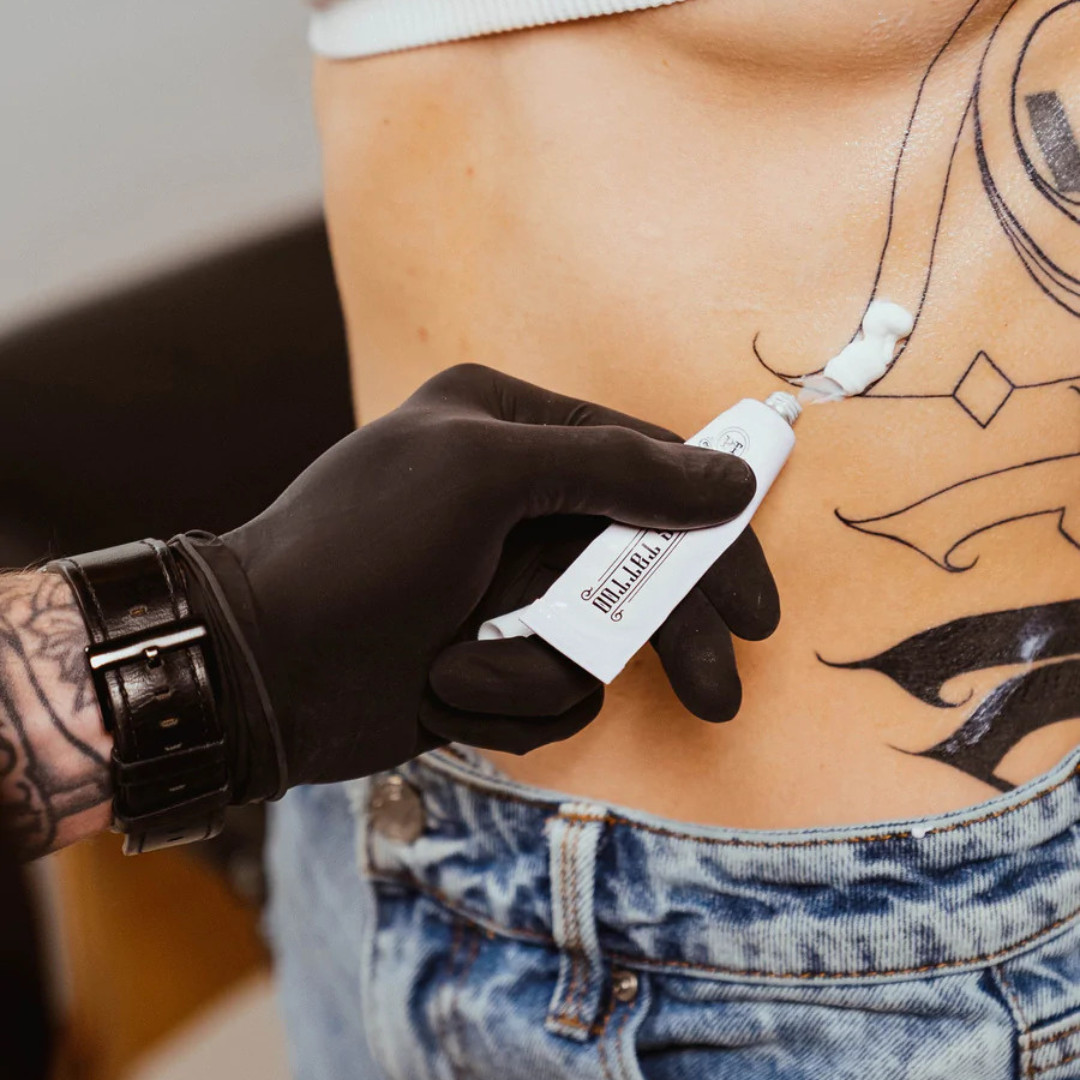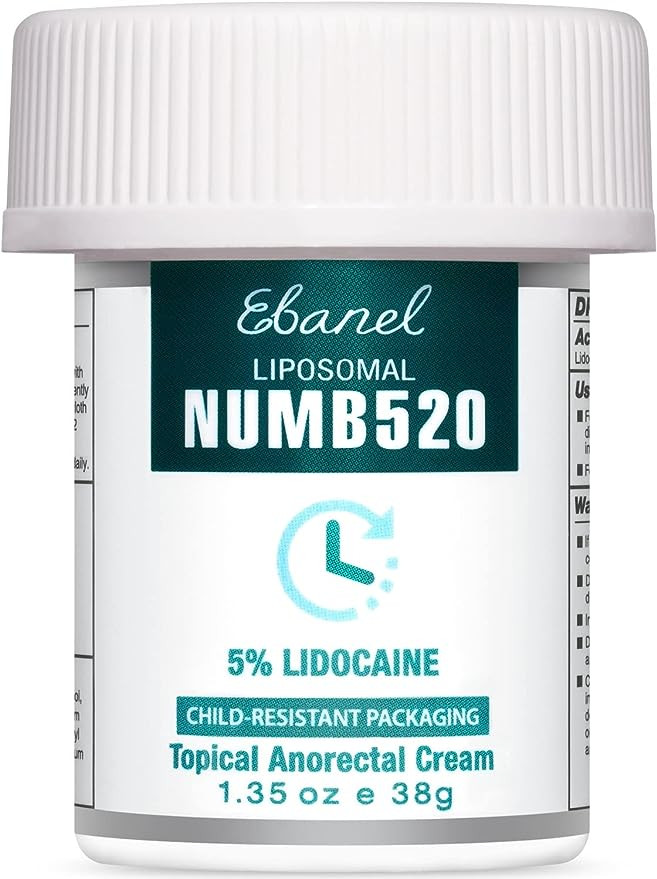Tattoo numbing cream is your ally against tattoo pain, providing relief during your inking session. If you’re exploring the world of tattoos and seeking a more comfortable experience, tattooat.com offers insights into pain management, including the use of effective numbing solutions and the best ways to prepare for your session. To ease discomfort during the tattoo process, consider exploring options like topical anesthetics, pain-relieving balms, and pre-tattoo care strategies.
1. What Exactly Are Tattoo Numbing Creams?
Tattoo numbing creams are topical anesthetics designed to minimize pain during the tattoo process. These creams work by temporarily blocking nerve signals in the treated area, offering a more comfortable experience.
Numbing creams are applied to the skin before the tattoo session, reducing pain and allowing for longer, more intricate work. These creams contain active ingredients that desensitize nerve endings, making the tattooing process more bearable. Tattoo numbing creams come in various forms, including creams, gels, and sprays, each with different application methods and effectiveness. For those new to tattoos, it’s important to choose the right numbing cream to ensure both comfort and safety.
2. How Do Tattoo Numbing Creams Actually Work?
Tattoo numbing creams work through a combination of nerve-blocking agents, nerve deadeners, and vasoconstrictors to provide pain relief. The effectiveness of these creams depends on their active ingredients and how they interact with your skin.
Nerve Blockers
Nerve blockers utilize chemicals like tetracaine and benzocaine to prevent pain signals from reaching the brain. These chemicals temporarily block the nerve pathways, reducing the sensation of pain in the treated area. Nerve blockers are effective for smaller tattoos in less sensitive areas, providing significant pain relief. However, for larger tattoos in more sensitive areas, they are often used in combination with nerve deadeners for enhanced effectiveness.
Nerve Deadeners
Nerve deadeners, containing ingredients like lidocaine, temporarily stop the nerves from functioning instead of just blocking pain signals. Lidocaine prevents nerves from transmitting pain signals, providing a more profound numbing effect. While highly effective, nerve deadeners don’t penetrate deep enough to completely eliminate pain from the tattoo needles. These creams are applied topically and can significantly reduce discomfort during the tattooing process.
Vasoconstrictors
Vasoconstrictors contain ingredients like epinephrine, which constrict blood vessels, reducing blood flow to the tattooed area. Reduced blood flow minimizes bleeding, making the tattooing process cleaner and more efficient. Vasoconstrictors also help to prolong the effects of other numbing agents by slowing their absorption into the bloodstream. These agents are often used during the tattooing process to reduce inflammation and swelling, enhancing comfort.
3. Are There Any Side Effects Associated With Tattoo Numbing Creams?
While tattoo numbing creams are generally safe when used as directed, some potential side effects can occur, especially for those with sensitive skin or pre-existing skin conditions. It is important to be aware of these possible reactions to ensure safe use.
Common side effects may include:
- Itching: The numbing agents can sometimes cause mild to intense itching in the treated area.
- Redness: Skin irritation can lead to redness around the application site.
- Inflammation/Swelling: Some individuals may experience swelling or inflammation.
- Burning/Tingling Sensation: A burning or tingling sensation can occur as the cream takes effect or wears off.
- Rash: Allergic reactions to the cream’s ingredients can manifest as a rash.
If you experience any of these side effects, discontinue use and consult with a healthcare professional. Always perform a patch test before applying the cream to a large area to check for adverse reactions.
4. How Do You Correctly Apply Tattoo Numbing Creams In 5 Easy Steps?
Applying tattoo numbing cream correctly is essential for achieving the best results. Here are five steps to ensure proper application:
Step 1: Clean the Area
Thoroughly clean the skin with soap and water to remove dirt, oils, and impurities. Pat the area dry with a paper towel or let it air dry to ensure the skin is clean and ready for the cream.
Step 2: Wear Disposable Gloves
Wear latex gloves to prevent the numbing cream from affecting unintended areas. This ensures the cream is only applied to the specific area you want numbed for the tattoo.
Step 3: Apply the Cream
Apply the numbing cream as directed by the manufacturer. Use your discretion if the directions are vague, applying a similar amount to what you would use for a rash ointment.
Step 4: Wrap the Area (If Needed)
If the cream is not fast-acting, wrap the area with saran wrap to generate body heat and speed up the activation process. Leave it on for about 30 minutes, but do not exceed one hour to avoid potential adverse effects.
Step 5: Rinse the Cream Off
Unless otherwise stated, rinse the cream off before the tattooing starts to prevent irritation caused by topical creams on broken skin. Some vasoconstrictors can be reapplied every 15-20 minutes during the session to prolong the numbing effect.
 Applying Numbing Cream for Painless Tattooing
Applying Numbing Cream for Painless Tattooing
5. What Should You Absolutely Avoid When Using Numbing Creams?
There are several important “no-nos” to keep in mind when using numbing creams to ensure your safety and the quality of your tattoo.
Don’t Lie to Your Tattoo Artist
Always inform your tattoo artist if you have used a numbing cream. Failure to disclose this information can affect the tattoo’s outcome, and in emergencies, your artist needs to know what you’ve been exposed to during the session.
Avoid Glycerin-Based Creams
Avoid numbing creams with glycerin as the main ingredient, as they can make the skin slippery, complicating the artist’s work.
Don’t Overdose
Do not use excessive amounts of numbing cream in an attempt to increase its effectiveness. Overdosing can lead to adverse effects.
Avoid Relying on Numbing Creams
Tattoo numbing creams should not be a constant necessity. Most tattoos are small and may not require numbing. Embrace the pain as part of the process when possible.
Don’t Apply After Tattooing
Never apply a pre-numb cream after getting a tattoo, as it can delay healing and potentially ruin the tattoo. Use aftercare products specifically designed for that purpose.
6. What Are Some Recommended Tattoo Numbing Creams Available?
Selecting the right tattoo numbing cream can greatly enhance your tattoo experience. Here are six top-rated options to consider.
Ebanel Numb 520
With a 5% lidocaine concentration, Ebanel Numb 520 cream works quickly and lasts for up to two hours after application. It starts working in less than five minutes, peaking at 20 minutes to soothe irritation, reduce pain, and calm itching. Being water-based, it prevents greasy messes and simplifies cleaning.
 Ebanel Numb 520 for Tattooing
Ebanel Numb 520 for Tattooing
Uber Numbing Cream
Uber Numbing Cream also contains 5% lidocaine, along with soothing agents like Vitamin E to reduce inflammation and moisturize the skin. It reaches its peak effect in 20-25 minutes, lasting up to an hour, with some users reporting effects lasting up to four hours.
Dr. Numb Cream
Containing a 5% lidocaine concentration, Dr. Numb Cream starts working in as little as 15 minutes to numb tissue for two to four hours. It is versatile, suitable for tattoos, bikini waxes, and ear piercings.
Hush Spray
Hush Spray is a popular choice with 4% lidocaine and is epinephrine-free (non-vasoconstricting). This FDA-approved numbing spray contains aloe, propylene glycol, chamomile, and menthol to soothe and hydrate the skin while providing over two hours of pain relief.
Advanced Numb
Advanced Numb is effective for tattoo numbing and also provides relief from soreness, burning, itching, and hemorrhoids. It works for up to two hours, penetrating deeply without leaving greasy residue.
Bactine Max
Once the skin is broken, many numbing creams can become counterproductive and delay healing. Bactine Max is formulated with 4% lidocaine and antiseptic ingredients to keep the wound clean as it heals, without the stinging effect of alcohol-based products.
 Bactine Max for Tattoo Aftercare
Bactine Max for Tattoo Aftercare
7. What Else Should You Consider When Choosing Tattoo Numbing Creams?
When selecting a tattoo numbing cream, keep in mind that the effects can vary from person to person. While one brand might work well for someone, it may not have the same effect on you. Doing your own research and considering personal factors is crucial.
Always discuss the use of tattoo numbing cream with your tattoo artist beforehand. They can offer valuable advice and help you make the best decision. At tattooat.com, we connect you with experienced artists who can guide you through the process, ensuring a safe and comfortable tattoo experience. According to a study by Portland State University’s Art Department in July 2025, discussing pain management options with your artist can significantly improve your overall satisfaction.
If your artist is not comfortable with numbing creams, explore alternative pain management methods, such as icing, using a stress ball, taking breaks, listening to music, and practicing breathing exercises. Communicating openly with your artist and preparing in advance can make your tattoo session more manageable.
8. How Do You Prepare For Your Tattoo Appointment?
Preparing for your tattoo appointment involves several steps to ensure a smooth and comfortable experience. Start by getting a good night’s sleep and avoiding alcohol or drugs, as these can thin your blood and increase bleeding during the tattoo process. Hydrate well by drinking plenty of water in the days leading up to your appointment to keep your skin supple and receptive to the ink.
On the day of your appointment, wear comfortable clothing that allows easy access to the area being tattooed. Eat a substantial meal beforehand to maintain stable blood sugar levels, which can help you better tolerate the pain. Bring distractions like music, a book, or a stress ball to help manage any anxiety or discomfort. If you’re considering using a numbing cream, discuss this with your tattoo artist beforehand to ensure it aligns with their practices and doesn’t interfere with the tattooing process. Following these steps will contribute to a more pleasant and successful tattoo session.
9. What Are The Best Aftercare Practices For A New Tattoo?
Proper aftercare is crucial for ensuring your new tattoo heals correctly and maintains its vibrancy. Start by keeping the bandage applied by your tattoo artist on for the recommended duration, usually a few hours. Once removed, gently wash the tattoo with mild, fragrance-free soap and lukewarm water, then pat it dry with a clean paper towel.
Apply a thin layer of tattoo-specific aftercare ointment or a fragrance-free moisturizer to keep the skin hydrated and prevent scabbing. Avoid petroleum-based products, as they can clog pores. Wash the tattoo twice daily and apply moisturizer as needed to keep the area moist but not overly saturated.
During the healing process, avoid soaking the tattoo in water, such as in baths, pools, or hot tubs, as this can increase the risk of infection and ink loss. Protect the tattoo from direct sunlight by wearing loose clothing or using a tattoo-specific sunscreen. Do not pick or scratch at scabs, as this can damage the tattoo and lead to scarring.
Following these aftercare practices diligently will help your tattoo heal quickly and maintain its appearance for years to come.
10. What Are Some Emerging Trends In Tattoo Art?
The world of tattoo art is constantly evolving, with new styles and techniques emerging regularly. One significant trend is the rise of micro-realism, where artists create incredibly detailed and lifelike tattoos on a small scale. This style often involves portraits, nature scenes, or intricate designs that showcase the artist’s precision and skill.
Another popular trend is the incorporation of watercolor effects, where tattoos mimic the appearance of watercolor paintings with soft, blended colors and a fluid, ethereal look. These tattoos often feature vibrant hues and delicate details, creating a unique and artistic effect.
Geometric and abstract tattoos are also gaining traction, with artists using lines, shapes, and patterns to create visually striking and symbolic designs. These tattoos can be minimalist or complex, often incorporating personal meanings and cultural references.
Additionally, there’s a growing interest in sustainable and eco-friendly tattooing practices, with artists using organic inks, biodegradable materials, and cruelty-free products. This trend reflects a broader movement towards environmental consciousness within the tattoo community.
Staying informed about these emerging trends can inspire your next tattoo design and help you discover new artists and styles that resonate with your personal aesthetic.
FAQ: Tattoo Numbing Creams
1. How long does tattoo numbing cream last?
The duration of numbing effect varies but generally lasts between 1 to 3 hours, depending on the product and individual factors.
2. Can I apply tattoo numbing cream myself?
Yes, you can apply it yourself, but follow the instructions carefully and consider consulting with your tattoo artist.
3. Will numbing cream affect the tattoo process?
Some artists find that numbing cream can make the skin rubbery, which might affect the ink’s absorption. Discuss this with your artist beforehand.
4. Are there any natural alternatives to numbing cream?
Some people try natural remedies like applying ice or using calming balms, but their effectiveness varies.
5. What should I do if I have a bad reaction to numbing cream?
Discontinue use immediately and consult a healthcare professional.
6. Can I use numbing cream on any part of my body for a tattoo?
While generally safe, certain areas like mucous membranes should be avoided. Consult with your artist.
7. How far in advance should I apply numbing cream before my tattoo appointment?
Apply the cream about 30-60 minutes before your appointment, following the product instructions.
8. Does tattoo numbing cream work for everyone?
Effectiveness varies from person to person, and some individuals may not experience the full numbing effect.
9. Can I reapply numbing cream during the tattoo session?
Some vasoconstrictors can be reapplied during the session. Follow product instructions and your artist’s advice.
10. Where can I buy reliable tattoo numbing cream?
Purchase from reputable pharmacies or online retailers that provide authentic products with clear usage instructions.
Eager to explore stunning tattoo designs, connect with talented artists, and gain essential knowledge about the art of tattooing? Visit tattooat.com today to discover a world of inspiration and expertise. Whether you’re looking for your first tattoo or seeking to expand your ink collection, tattooat.com is your ultimate resource. Address: 1825 SW Broadway, Portland, OR 97201, United States. Phone: +1 (503) 725-3000. Website: tattooat.com.
